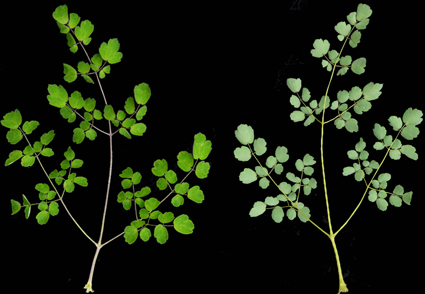Abstract
Based on critical observations on herbarium specimens (including type material) and living plants in the wild, we demonstrate that the holotype itself and the type collection of Thalictrum chayuense, which was described from Zayu county in southeastern Xizang (Tibet), China, are mixed, consisting of two taxa, T. chayuense and T. nepalense. Lectotypification is proposed for T. chayuense herein. Thalictrum chayuense is then determined to be conspecific with T. tsawarungense, a species described also from Zayu in southeastern Xizang. We therefore reduce T. chayuense to the synonymy of T. tsawarungense.
References
Finet, A.E. & Gagnepain, F. (1903) Contributions a la flore de l’Asie orientale d’aprés l’herbier du muséum de Paris. Bulletin de la Société Botanique de France 50: 600–625. https://doi.org/10.1080/00378941.1903.10831058
Franchet, A. (1889?1890) Plantae Delavayanae. Paul Klincksieck, Paris, 240 pp. https://doi.org/10.5962/bhl.title.10529
Fu, D.Z. & Zhu, G.H. (2001) Thalictrum Linnaeus. In: Wu, Z.Y., Raven, P.H. & Hong, D.Y. (Eds.) Flora of China, vol. 6. Science Press, Beijing & Missouri Botanical Garden Press, St. Louis, pp. 282–302.
Grierson, A.J.C. (1984) Ranunculaceae. In: Grierson, A.J.C. & Long, D.G. (Eds.) Flora of Bhutan, vol. 1, part 2. Royal Botanical Garden, Edinburgh, London, pp. 283?321.
Hara, H. (1979) Ranunculaceae. In: Hara, H. & Williams, L.H.J. (Eds.) An Enumeration of the Flowering Plants of Nepal, vol. 2. British Museum (Natural History), London, pp. 9–23.
Hooker, J.D. & Thomson, T. (1855) Ranunculaceae. In: Hooker, J.D. & Thomson, T. (Eds.) Flora Indica, vol. 1. W. Pamplin, London, pp. 1–60.
Lecoyer, J.C. (1885) Monographie du genre Thalictrum. Bulletin de la Société Royale de Botanique de Belgique 24: 78–324.
Li, H. & Li, R. (2020) Plant Resources and Geography of the Gaoligong Mountains in Southeast Tibet. Hubei Science and Technology Press, Wuhan, 1288 pp.
Linnaeus, C. (1753) Species Plantarum. Laurentii Salvii, Holmiae, 1200 pp.
McNeill, J. (2014) Holotype specimens and type citations: General issues. Taxon 63: 1112?1113. https://doi.org/10.12705/635.7
Rau, M.A. (1993) Ranunculaceae. In: Sharma, B.D., Balakrishnan, N.P., Rao, R.R. & Hajra, P.K. (Eds.) Flora of India, vol. 1. Botanical Survey of India, Calcutta, pp. 1–145.
Turland, N.J., Wiersema, J.H., Barrie, F.R., Greuter, W., Hawksworth, D.L., Herendeen, P.S., Knapp, S., Kusber, W.-H., Li, D.-Z., Marhold, K., May, T.W., McNeill, J., Monro, A.M., Prado, J., Price, M.J. & Smith, G.F. (2018) International Code of Nomenclature for algae, fungi, and plants (Shenzhen Code). Regnum Vegetabile 159. Koeltz Botanical Books, Glashütten, 254 pp. https://doi.org/10.12705/Code.2018
Wang, W.T. (1982a) Notulae de Ranunculaceis sinensibus (V). Acta Botanica Yunnanica 4: 129?137.
Wang, W.T. (1982b) Thalictrum L. In: Wang, W.T. (Ed.) Iconographia Cormophytorum Sinicorum, suppl. 1. Science Press, Beijing, pp. 410?431.
Wang, W.T. (1985) Thalictrum L. In: Wu, C.Y. (Ed.) Flora Xizangica, vol. 2. Science Press, Beijing, pp. 63?76.
Wang, W.T. (1993) Thalictrum L. In: Wang, W.T. (Ed.) Vascular Plants of the Hengduan Mountains, vol. 1. Science Press, Beijing, pp. 495?505.
Wang, W.T. (2000a) Thalictrum L. In: Wu, Z.Y. (Ed.) Flora Yunnanica, vol. 11. Science Press, Beijing, pp. 153–177.
Wang, W.T. (2000b) Thalictrum L. In: Fu, L.K. & Hong, T. (Eds.) Higher Plants of China, vol. 3. Qingdao Publishing House, Qingdao, pp. 459?481.
Wang, W.T. (2018a) Thalictrum nepalense, a new species of Ranunculaceae from Nepal. Bulletin of Botanical Research 38: 641?643.
Wang, W.T. (2018b) Thalictrum (Ranunculaceae) in China. Peking University Press, Beijing, 376 pp.
Wang, W.T. & Wang, S.H. (1979a) Addenda. In: Anonymous (Ed.) Flora Reipublicae Popularis Sinicae, vol. 27. Science Press, Beijing, pp. 603–622.
Wang, W.T. & Wang, S.H. (1979b) Thalictrum L. In: Anonymous (Ed.) Flora Reipublicae Popularis Sinicae, vol. 27. Science Press, Beijing, pp. 502–592.
Wu, C.Y. (1984) Index Florae Yunnanensis, vol. 1. Yunnan People’s Publishing House, Kunming, 1070 pp.
Wu, Y.H. (2008) The Vascular Plants and Their Eco-Geographical Distribution of the Qinghai-Tibetan Plateau. Science Press, Beijing, 1369 pp.
Yonekura, K. (2008) Ranunculaceae. In: Ohba, H., Iokawa, Y. & Sharma, L.R. (Eds.) Flora of Mustang, Nepal. Kodansha Scientific Ltd., Tokyo, pp. 61?94.
Zeng, Y.P., Yuan, Q. & Yang, Q.E. (2021) Thalictrum minshanicum and T. pseudoramosum (Ranunculaceae), two new species from China. Phytotaxa 502: 133?148. https://doi.org/10.11646/phytotaxa.502.2.2
Zeng, Y.P., Yuan, Q. & Yang, Q.E. (2022) Thalictrum fusiforme (Ranunculaceae), described from southeastern Xizang (Tibet), China, is merged with T. rostellatum, a Sino-Himalayan species. Phytotaxa 545: 234?260. https://doi.org/10.11646/phytotaxa.545.3.1


